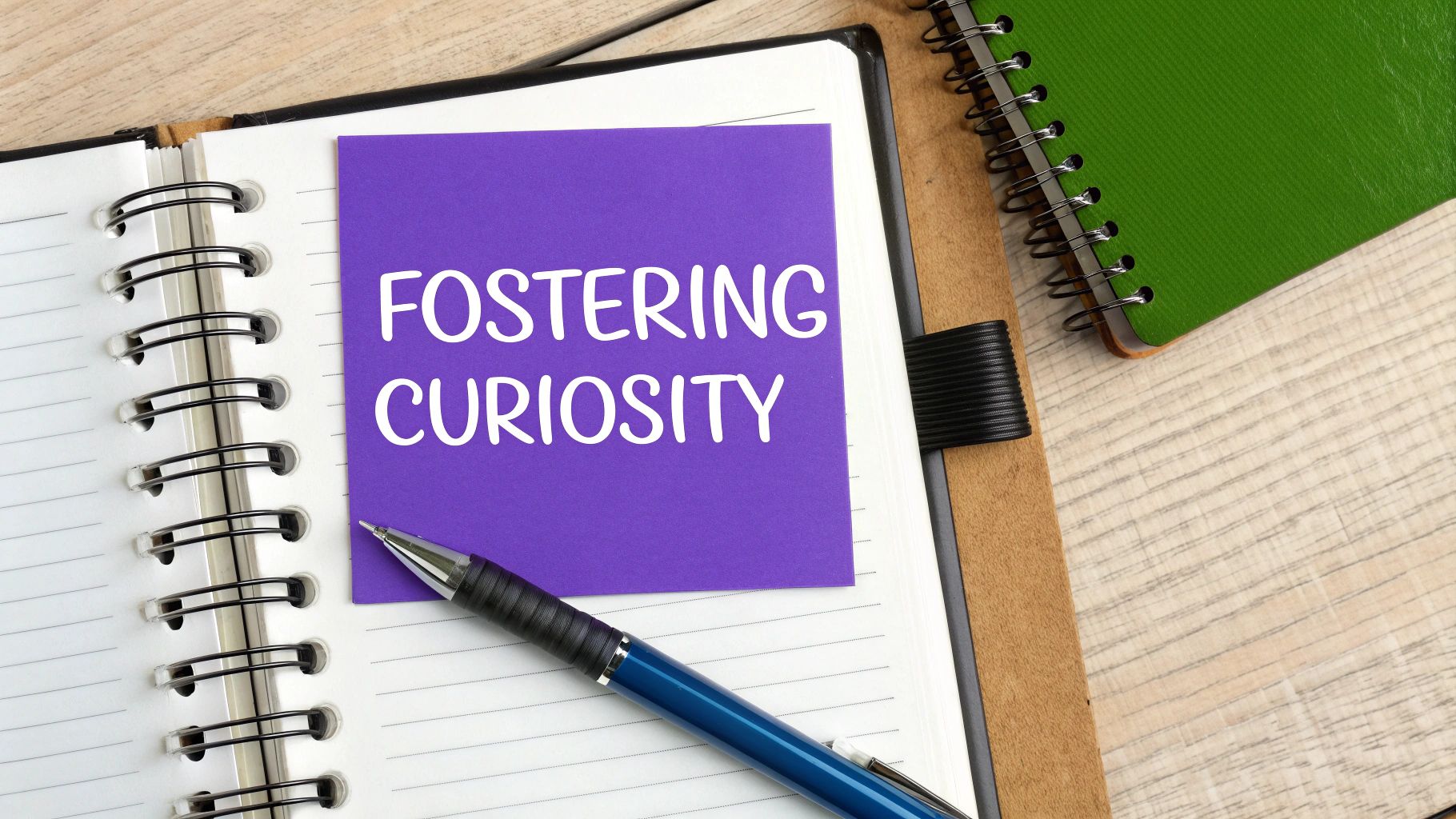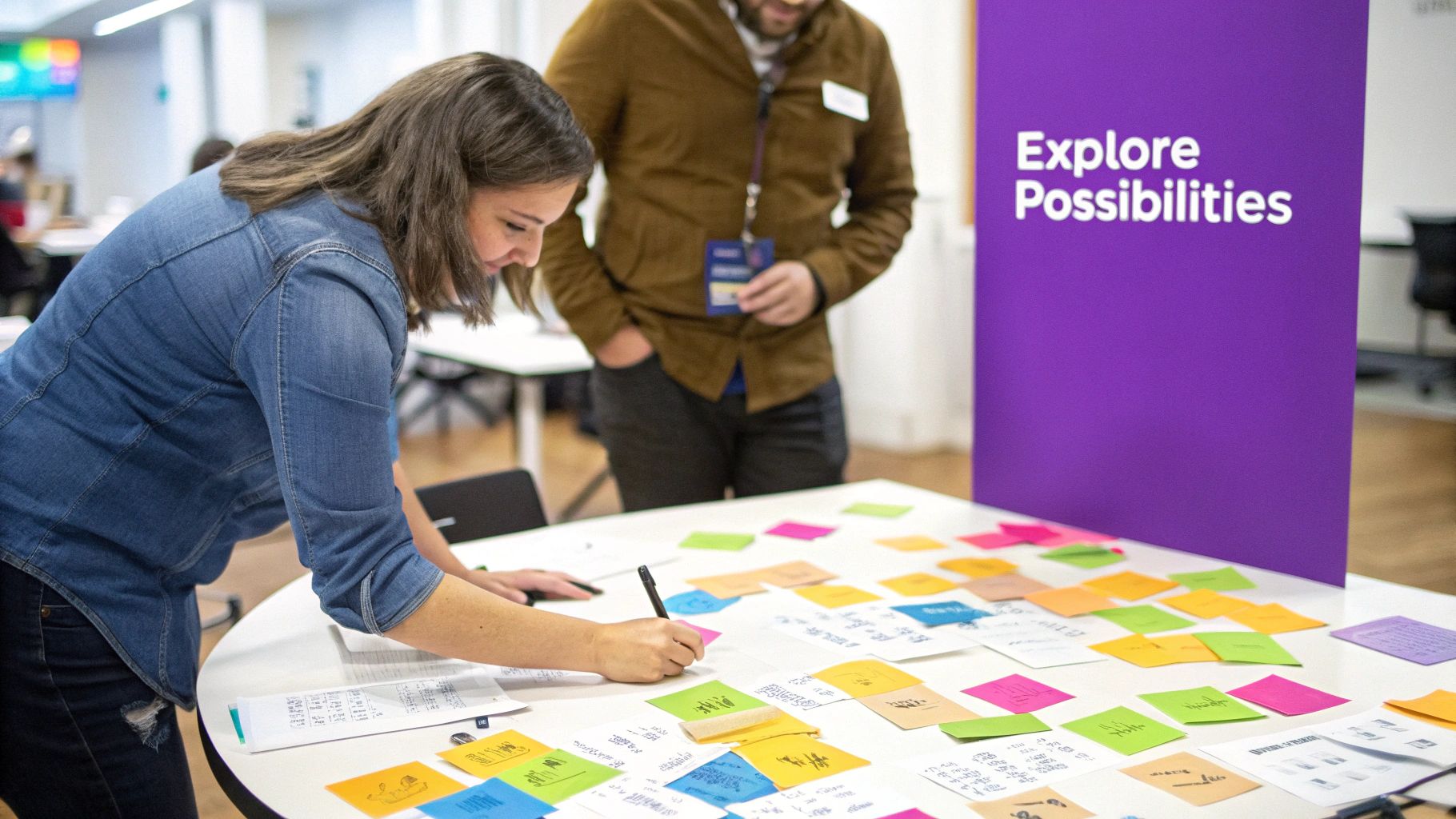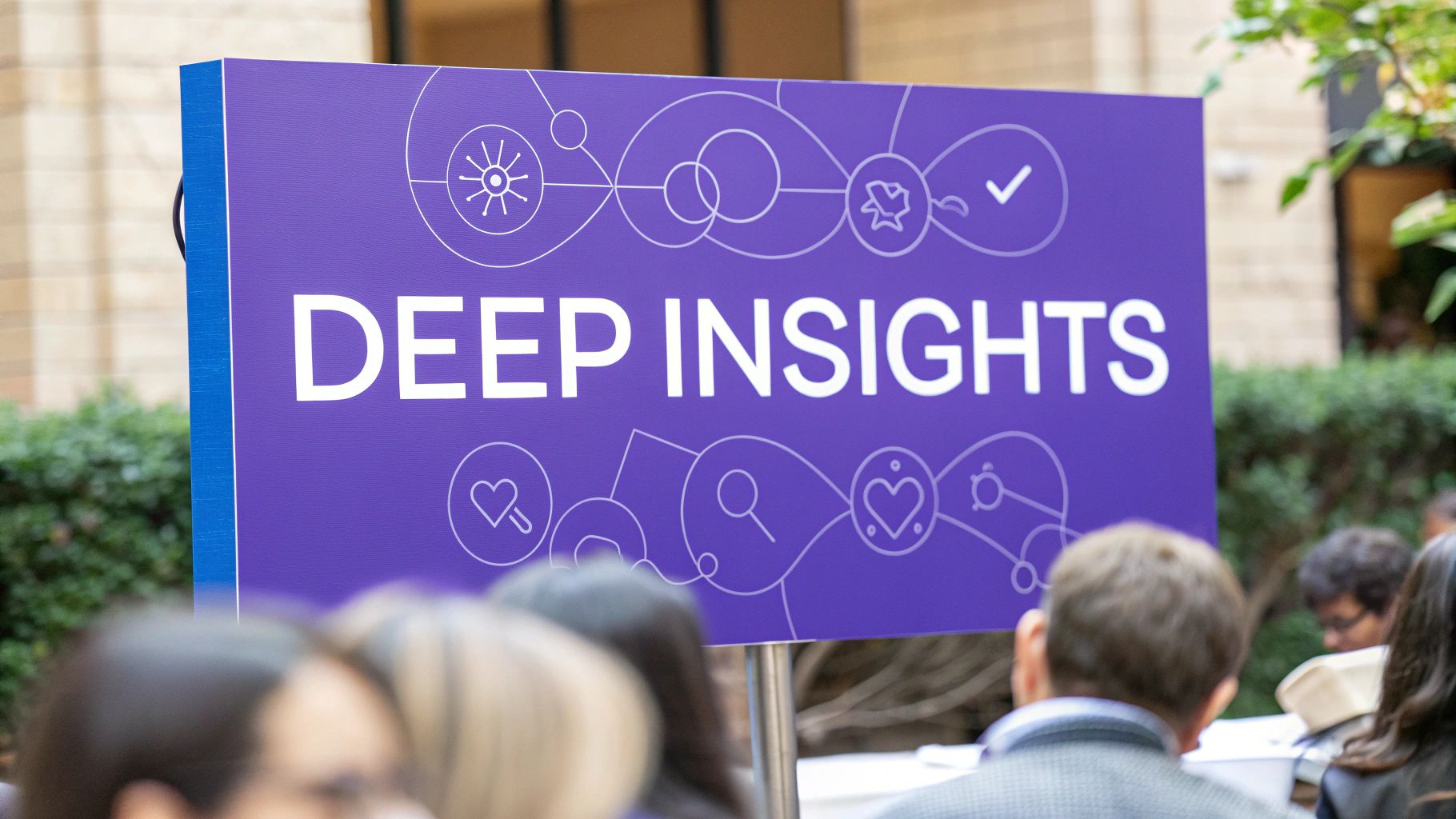The Power and Psychology of Open-Ended Questions
Questions that invite detailed responses, rather than simple yes/no answers, help uncover deeper insights and create meaningful discussions. These open-ended questions get people to share their thoughts fully and reveal important details that might otherwise stay hidden.
How Open-Ended Questions Work
When you ask open-ended questions, you tap into how people naturally communicate. These questions give others space to explain their views and what motivates them. For example, instead of "Did you like the product?" try "What did you think about the product?" This small change leads to much richer feedback about the customer's actual experience.
The magic of open-ended questions comes from their ability to spark critical thinking. They typically start with words like 'how', 'why', 'what' or phrases like 'tell me about'. For instance, asking "What factors matter most when you choose a product like ours?" helps identify what truly drives customer decisions. Learn more about crafting effective questions from Retently's guide to open-ended questions.
Practical Examples of Open-Ended Questions
Here are some real-world examples showing how open-ended questions work in different settings:
- Customer Feedback: "What could we do to improve your experience with our company?"
- Team Brainstorming: "What are some innovative solutions to this challenge?"
- Performance Reviews: "How can you contribute more effectively to the team's goals?"
- Personal Reflection: "What are my biggest strengths and how can I leverage them?"
Writing Strong Open-Ended Questions
Creating good open-ended questions takes some practice. Here are the key things to remember:
- Start with question words: Use "what," "how," "why," "describe," or "tell me about"
- Focus on their view: Ask questions that let people share their own thoughts and experiences
- Stay neutral: Avoid questions that push people toward a certain answer
- Keep it simple: Short, clear questions work best for getting detailed responses
Using open-ended questions helps you learn more and build better connections in all areas of life. They're especially helpful for remote teams who need clear communication and fresh ideas. Tools like Bulby can help remote teams brainstorm more effectively using these question techniques.
Improving Customer Research With Better Questions

Many companies are moving away from basic surveys with yes/no answers. These simple methods often miss important details about what customers really think and feel. Instead, businesses are discovering the value of open-ended questions that allow people to share their full thoughts and experiences.
Getting Better Insights Through Open-Ended Questions
When you ask open-ended questions, customers can explain their views in their own words. For example, rather than asking "Did you like our product?", try asking "What are your thoughts about our product?" This gives people space to share both positive and negative feedback. It helps companies understand not just what customers think, but why they think it.
Open-ended questions can also reveal problems and opportunities you might have missed. By asking questions like "What challenges do you face with similar products?", companies can spot ways to improve their offerings. This approach digs deeper than basic satisfaction ratings to uncover what really matters to customers.
Building Good Questions Step by Step
The key to good open-ended questions is building trust and making it easy for people to share honest feedback. Start with broader questions before moving to more specific ones based on what you learn. This creates a natural conversation flow. According to a case study, Reflections Holidays used this approach with their Net Promoter Score surveys over five years. By analyzing detailed customer responses, they knew exactly where to invest in improvements, leading to better satisfaction and more revenue.
Sample Questions for Customer Research
- Understanding Needs: "What challenges do you face when using [product/service area]?"
- Product Input: "How do you feel about our product's features?"
- Service Feedback: "What would make our customer service better for you?"
- Future Ideas: "What new features would you like us to add?"
- Competition: "What do you think about similar products from other companies?"
These examples show how open-ended questions can gather rich customer insights. By using these question strategies, companies can learn more about their customers, create better products, and grow their business. The right questions lead to better understanding of what customers really want and need.
Elevating Classroom Engagement Through Dynamic Questioning

Teachers are always looking for better ways to get students involved in learning. One powerful approach is using open-ended questions thoughtfully. Unlike yes/no questions, open-ended questions push students to think deeper, explain their reasoning, and develop more complete understanding.
The Art of Crafting Effective Open-Ended Questions
Good open-ended questions need careful planning to spark student curiosity. For example, rather than "Did you understand the reading?", try "What do you think motivated the main character's actions?" This kind of question gets students analyzing and interpreting the text, leading to richer class discussions.
You can shape open-ended questions for different learning goals. To check basic understanding, ask "What were the key events in this time period?" To push critical thinking further, try "How would you evaluate the author's main argument?" This flexibility makes open-ended questions useful across many teaching situations.
Building Question Sequences for Deeper Understanding
Effective questioning isn't just about individual questions – it's about creating a series that guides students to deeper insights. Start broad to establish basics, then get more specific. This helps students build on their initial thoughts and develop more detailed perspectives.
For instance, with a science lesson, begin with "What do you notice about this experiment?" Then follow up with questions like "How do these observations connect to the principles we learned?" This step-by-step questioning creates an engaging environment where student responses shape the discussion.
Adapting Questions to Student Responses and Creating an Inclusive Classroom
Open-ended questions should be adjusted based on how students respond. If someone gives a short answer, ask follow-up questions to draw out more details. When you get a thoughtful response, use it to explore related ideas deeper. This creates a responsive classroom where every student feels their input matters. Open-ended questions work especially well for complex topics like environmental science. Teachers use them to help students discuss and explore their findings in detail. Learn more about this approach here.
Open-ended questions also help create an inclusive classroom atmosphere. By phrasing questions to welcome different viewpoints, teachers ensure all students feel comfortable joining the discussion. This builds community and shared learning, with every voice adding to the group's understanding. For online classes, tools can help structure these discussions effectively. Features for brainstorming and idea generation through carefully planned open-ended questions make virtual classrooms more engaging for everyone.
Mastering Professional Interviews Through Strategic Questions
Finding the right candidate takes more than a basic list of questions. It requires a thoughtful approach using open-ended questions that reveal deeper insights into a person's experiences, thinking, and fit with your organization. This method helps uncover valuable information that simple yes/no questions often miss.
Why Open-Ended Questions Are Essential for Interviews
Open-ended questions encourage candidates to share detailed stories and examples. Rather than asking "Are you a team player?" try "Tell me about a challenging team project you worked on. What role did you take and how did you help the team succeed?" This gives candidates space to demonstrate their skills through real examples.
These questions do more than just gather information – they also show how well candidates can communicate and express their ideas. You'll get a better sense of their enthusiasm for the role and genuine interest in joining your company.
Open-Ended Questions Examples for Professional Interviews
Here are key categories of open-ended questions to help assess different aspects of candidates:
-
Problem-Solving:
- "Describe a time you faced a complex problem at work. How did you approach it, and what was the outcome?"
- "Tell me about a time you had to make a difficult decision with limited information. What was your thought process?"
-
Leadership:
- "Describe your leadership style. Give me an example of a time you successfully led a team to achieve a specific goal."
- "How do you motivate and inspire your team members?"
-
Cultural Fit:
- "Describe your ideal work environment. What factors contribute to a positive and productive team dynamic?"
- "Tell me about a time you had to adapt to a significant change in the workplace. How did you handle it?"
-
Skills and Experience:
- "Describe a project you are particularly proud of. What were the challenges, and how did you overcome them?"
- "How do you plan to use your existing skills to contribute to our company's growth?" Open-ended questions let candidates give complete, detailed answers beyond simple yes/no responses. This helps interviewers better understand the candidate's capabilities and potential contributions. Learn more about open-ended questions here.
Utilizing Open-Ended Questions to Evaluate Soft Skills
While technical abilities matter, soft skills often determine long-term success in an organization. Open-ended questions excel at revealing communication style, teamwork approach, adaptability, and problem-solving abilities.
Asking candidates to share specific examples of using these skills in real situations provides much better insight than having them rate themselves. Their stories reveal their actual behaviors and work patterns.
Developing Your Own Powerful Interview Questions
Creating strong interview questions starts with identifying what skills and qualities are most important for the role and your company culture. Build questions that ask candidates to share concrete examples showing how they've used those skills successfully. This gives you a clearer picture of their abilities and potential. Bulby offers tools to help remote teams collaborate on developing effective interview questions and improving their hiring process.
Accelerating Personal Growth Through Powerful Questions

The best coaches and mentors know how to ask open-ended questions that spark real insight. These questions go beyond simple yes/no answers to help people explore their thoughts and feelings more deeply. This exploration is key for meaningful personal development.
Unlocking Potential Through Thought-Provoking Questions
Good questions lead to breakthrough insights. Rather than asking "Are you happy with your progress?", a skilled coach might ask "What parts of your progress make you proud, and where do you see room for growth?" This helps people reflect more carefully on their experiences and challenges.
When people can clearly see their hidden potential, they become more motivated to overcome obstacles and make real changes. The right questions help bring natural strengths and talents into focus.
Building a Framework for Meaningful Self-Reflection
Expert coaches guide people through structured reflection by asking questions in a thoughtful sequence. Like following a map, this helps create clarity about where you've been, what matters most to you, and where you want to go.
Think of it like building a house – you need a solid foundation and framework before adding the details. Similarly, good questions provide the structure needed for lasting personal growth.
Open-Ended Questions Examples for Personal Growth
Here are some powerful questions coaches use to spark insight:
- Exploring Values: "What principles guide your most important decisions?"
- Identifying Strengths: "What activities come naturally to you, and how could those talents help reach your goals?"
- Addressing Challenges: "What specific things are holding you back, and what small steps could help overcome them?"
- Setting Goals: "What do you want to achieve this year, and what actions will move you forward?"
- Enhancing Self-Awareness: "How do your beliefs shape your choices and results?"
Adapting Your Approach for Individual Needs
Each person needs a slightly different approach based on their unique personality and learning style. Some people thrive with direct questions while others need a gentler touch. The key is creating a space where people feel safe exploring their thoughts openly.
Like a gardener who knows each plant needs different care, a good coach adjusts their style to help each person grow. Tools like Bulby can help track progress and keep conversations focused, especially for remote coaching sessions.
Maximizing Question Impact: Advanced Techniques and Common Pitfalls

Let's explore how to get the most value from open-ended questions through smart techniques while avoiding typical mistakes. Success comes down to proper timing, context, and follow-up strategies.
Setting the Right Time and Place
The impact of your questions depends heavily on when and how you ask them. For instance, jumping straight into deep questions in a customer survey can feel jarring. Start with broader questions to build comfort before getting specific.
The setting matters too. Asking "What do you think about this project?" will get different responses in a casual team meeting versus a formal review. Match your questions to the environment to get useful answers.
Following Up for Better Answers
Basic responses like "It's fine" often hide deeper thoughts. This is where good follow-up questions shine. Try phrases like "Could you tell me more about that?" or "What specific parts make you feel that way?" to dig deeper.
These extra questions show you're truly interested and create space for detailed responses. Think of it like carefully peeling an onion to reach the core issue.
Handling Tricky Situations
Even with good planning, you might hit roadblocks or get vague answers. Watch out for leading questions that push people toward certain answers. "Don't you think this is unnecessary?" subtly pressures agreement.
Another common issue is overwhelming people with too many questions at once. Break complex topics into smaller, focused questions for better results.
Always Keep Improving
Getting better at questioning takes ongoing practice. Review how well your questions work: Are you getting helpful insights? Do certain patterns keep coming up?
Ask colleagues for honest feedback about your questioning style. Their input can spot blind spots and ways to improve. Keep refining your approach over time.
Key Mistakes to Watch For
- Leading Questions: Keep questions neutral to get honest answers
- Question Overload: Stick to one clear question at a time
- Weak Follow-Up: Don't accept surface-level answers – probe deeper
- Wrong Context: Consider the setting when choosing questions
By using these techniques and avoiding common traps, you'll get more valuable insights from your questions. This leads to smarter decisions and stronger working relationships.
Want to improve your remote team's brainstorming with better questions? Try Bulby today! See how Bulby can boost your team's creativity

